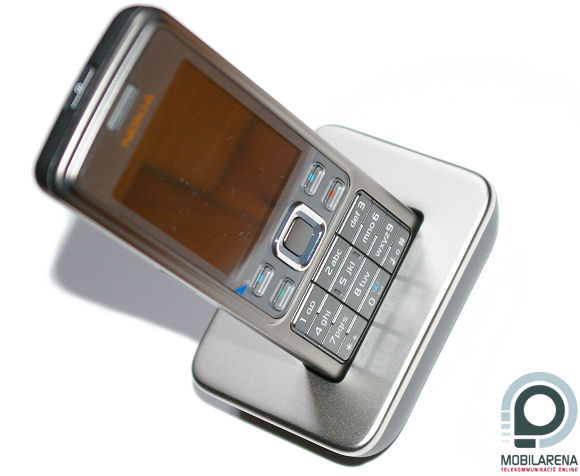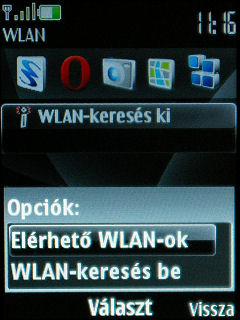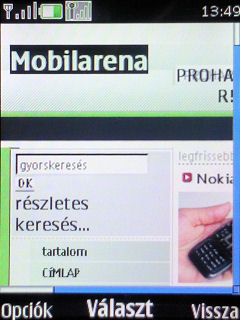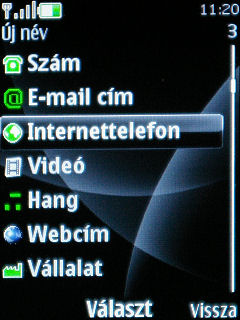Introduction, packaging
Perfect cell phone… there is no such thing, many of you would say, as like all things on the world, a phone can’t be perfect. Still, I’ve been thinking on this since a long time ago and I say that there is such a device; we just have to define what we compare perfection to. User expectations can’t be a comparison, as there are some handsets that are the most ideal for some users, but this can’t be a general measure. But we can take a look at how much is the handset good for what it has been designed for. And when considering this point of view I dare to say: there are perfect cell phones. I think that Sony Ericsson K750i was one at its time, iPhone is one and Nokia 6300 is somehow also a perfect phone.
The Finnish model doesn’t provide advanced file transfer features, it’s no multimedia computer, it was just called a nice, finely assembled phone and it really was one. And now we have its successor that has a trailing “i” that has been used a lot a while ago. This means built-in WiFi and VoIP-support.

The phone, provided by XXL GSM, came in a mid-sized, classy box, which had a DT-23 charger cradle, a HS-47 headset, a 512 MB memory card and a charger besides the phone. The cradle was a great surprise for me, as such an accessory has been included with a very low number of phones in the last couple of years, although I think that this is one of the most practical and most elegant way to charge a cell phone.
Hirdetés
Changes – outside and inside
Since 6300i is no “heavily tuned” device, I don’t want to say much neither about the exterior, nor about the interior, I’ll just mention the most important stuff besides the changes. The physical parameters of the phone are the same as the original handset’s, so it’s no ultra-thin, but still graceful phone – it’s 106.4 x 43.6 x 11.7 mm large and weighs 93 grams, which is 2 grams more than the predecessor. The design hasn’t changed a bit, the small Nokia fits perfectly in the hand, it’s easy to use, has a logical structure and it looks very sleek. The single color it’s available in is the grey you can see on the pictures. I liked the basic model’s colors somewhat better, but this isn’t bad either.
The materials used and the assembly are of the highest quality, there are no creaks, only a metal case and precise joints. Well, this is not perfectly true: the d-pad is not perfect, it gives a strange noise when using it, and it seemed to be of a much lower quality than the original – although it might just need some time. The other keys are okay, all of them need to be pressed quite hard to make them work.
On top of the front there is still no camera for video calls, as the “i”-phone still doesn’t support third generation networks. The display is the same one, with a diagonal of 2”, QVGA resolution and a fine picture quality. On the top there is the power button, there is a LED on each side, which blink in blue in case there is a missed event. On the bottom there is the miniUSB connector with a cover, along with the charger’s and the headset’s connector.
The phone uses Nokia’s popular Series 40 platform. We had a dedicated article about the platform’s speed, customizability and features. The software works perfectly again, it’s fast and has a logical structure.


The Nokia Maps software (included on the memory card) is new, which ships with some maps. Since I wasn’t a good friend of this app until now, I started to explore it a bit, but after seeing some Pocket PC navigation software, I found this quite disappointing, both in design and functions. After a couple of minutes I tried to search my home apartment, I typed the address, but unfortunately the phone couldn’t do anything with it, after half a minute of loading it hung up and restarted, so I didn’t bother with it anymore. The point is that with an external GPS receiver the phone is capable of navigation.


Nokia Maps software, mostly for browsing maps, since there is no internal GPS receiver
There are three games on the phone, these are Snake III, Soccer 3D and Sudoku. The list of applications also includes a converter, a world clock, Sensor, Yahoo Go and WidSets. All other software are the default ones, so those who are interested in further details of the Series 40 platform should read the review mentioned above!
Data transfer, WiFi, phone calls
I’ve already mentioned the lack of 3G, so the handset can operate only on GSM networks, it supports three frequency bands (900/1800/1900 MHz). The fastest supported data transfer protocol is EDGE, Bluetooth is of version 2.0 and supports the stereo profile. The bonus is that there is a WiFi receiver in the phone, which is 802.11b/g-comaptible – yup, there’s WiFi in a Series 40 phone; we haven’t seen such a thing before! I’d like to mention here that the voice quality of 6300i during calls is exceptionally good, but seriously I didn’t really have a phone in my hands recently that had such a clear, fine sound, although I had a couple of them for testing!


The wireless unit is the easiest to access via Active standby. The handset found all available networks in a matter of seconds and I’d say that it has a medium reception quality. If we prefer the main screen to be clean, then there’s still no trouble, as upon launching the browser the phone offers to search for WLAN networks. The default browser is a rather basic one, it’s not even close to the MiniMap one used on the Series 60 platform, I say that it’s usability in browsing is quite limited. Probably the designers knew this, as the popular Opera Mini is also installed on the phone, but unfortunately this still doesn’t make the experience much better.


Fortunately we can use the WiFi module for other things too, for example we can quickly download our emails – as there is an e-mail client on the phone that supports authenticated IMAP servers. There is VoIP support too, so we can use the phone for internet calls. For this we first have to configure this service, we have to define our VoIP provider, user name and password. After this we can take a look at our on-line contacts in a separate view, but we can try dialing directly from the contact list too, in case we have registered the contact’s ID. This of course works only if we’re connected to a WiFi network.
Multimedia
The camera is a 2 megapixel one, has fixed focus, the highest available resolution for images is 1200 x 1600 and 176 x 144 pixels for videos. The software can be familiar from older S40 models, it doesn’t have many settings, we can set JPEG compression amount, white balance, there are effects, self timer, night mode and that’s about it. Picture quality is rather good in this category, image noise level is medium, noise filtering is low, the dynamics range is low, but the camera can still be used to capture fun moments.

The phone is great in music, at least on the software side, as the included headset is still not the best. The player can display album covers, can filter tracks on the memory card by ID3 tags, it has an equalizer, can run in the background, so it’s all right. By the way the memory card has about 200 MB free by default; the internal memory is 30 MB large. Sound quality is surprisingly good when on handsfree, it looks like from the point of view of acoustics it does matter that the case is made of metal. The RDS FM radio is of course also included.


Battery, summary
The BL-4C battery has a capacity of 860 mAh, according to manufacturer information the phone provides 3 and a half hours of talk time on GSM networks and 3 hours on VoIP. I think that these numbers are accurate, the phone can take it for quite a long time, at an average use it asked for a charge only after three days.
Summary: Nokia 6300i is a great handset, just like its predecessor, so as a closing to the thoughts I’ve written in the introduction: it’s almost perfect for what it has been designed for. But unfortunately it’s just almost, as because the poor browser we can’t make full use of WiFi, but it’s still good that it’s included, at least there’s VoIP and emailing. Independently of these it’s still great as a phone, voice quality is really great and the Series 40 platform also does its job perfectly. It’s great in accessories too, although there should have been a GPS receiver for Nokia Maps, as now the handset can be used for navigation only with an external receiver – even though it will be quite limited even then. The lack of 3G probably hurts many people, but I am personally happy about it, as the exceptional voice quality and the long uptime are partially due to this – HSDPA addicts have what to play with anyway, there are quite a lot of smartphones from the Finnish manufacturer to choose from. The price of the phone is currently about €195 EUR and in this price category WiFi is a real curiosity and anyway: 6300i is perfect as a phone. It is recommended for everyone.
 |
| Nokia 6300i |
Bocha
Translated by Szaszati
Nokia 6300i has been provided by XXL GSM.
The handset can be purchased at:
Budapest VI. Jókai tér 6.
Budapest VI. Teréz körút 18.
On-line at www.xxlgsm.hu.
Specifications
| Nokia 6300i | ||
 | General | |
| Technology | GSM | |
| Size | 106.4 x 43.6 x 11.7 mm | |
| Weight | 93 grams | |
| Available colors | grey | |
| Display | ||
| Display diagonal | 2” | |
| Display resolution | 240 x 320 pixels | |
| Display type | TFT | |
| Number of colors | 16 million | |
| Memory | ||
| Phonebook capacity | 1000 entries | |
| SMS memory / max. MMS size | n/a / 300 KB | |
| Internal memory | 30 MB | |
| Memory expandability | microSD (512 MB card included) | |
| Data transfer | ||
| Frequency bands | 900/1800/1900 MHz | |
| GPRS / EDGE | Class 10 (4+1/3+2) / Class 10 (236.8 kbps) | |
| UMTS / HSDPA | none / none | |
| IrDA / Bluetooth | none / 2.0 (A2DP too) | |
| WiFi | 802.11b/g | |
| USB | 2.0 (miniUSB) | |
| Push-to-talk / RSS | present / none | |
| GPS receiver | none | |
| Basic functions | ||
| Profiles | present | |
| Vibra function | present | |
| Built-in handsfree | present | |
| Voice dialing / voice commands | present / present | |
| Sound recorder | present | |
| Alarm clock | present, also when turned off | |
| Predictive text entry | T9 | |
| Software | ||
| Platform | Series 40 5th edition | |
| WAP / HTML browser | 2.0 / present | |
| E-mail client | present (POP3, IMAP4, authenticated) | |
| Java | present, MIDP 2.0 | |
| Games | 3 | |
| Currency converter | present | |
| Extra software | Nokia Maps, Opera Mini, Sensor, Widsets | |
| Multimedia | ||
| Main camera | 2 megapixels, fixed focus | |
| Secondary camera | none | |
| Video recording | present (max. 176 x 144 pixels) | |
| Music player | present, can run in background | |
| Equalizer | present, with user presets | |
| FM radio | present | |
| Battery | ||
| Main battery | 860 mAh Li-Ion | |
| Standby time | 340 hours | |
| Talk time | 3 and a half hours | |
| Other | ||
| Charger cradle | ||



















